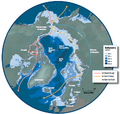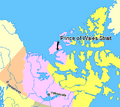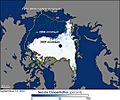Northwest Passage facts for kids
The Northwest Passage is a famous sea route that goes along the northern coast of North America, right through the icy Arctic Ocean. For a long time, this passage was mostly blocked by thick ice, making it very hard for ships to get through.
Hundreds of years ago, countries like Spain and Portugal were looking for new ways to reach Asia to trade for valuable goods. Portugal controlled the long sea route around the southern tip of Africa, called the Cape of Good Hope. Spain wanted its own route to Asia that it could control. This led many European countries to search for a possible western route, hoping to find a shortcut through North America.
It wasn't until 1903 that the Norwegian explorer Roald Amundsen finally became the first person to successfully sail through the entire Northwest Passage. His journey took three years, ending in 1906. Today, because of global warming, the ice in the Arctic is melting more and more. This is slowly making the Northwest Passage easier to navigate, which could change future shipping routes.
Contents
The Quest for a Shortcut
For centuries, explorers dreamed of finding a quick way to sail from Europe to Asia. They knew about the long journey around Africa, but they hoped for a shorter path through the northern parts of North America. This idea was very exciting for trade.
Early European Explorers
Many explorers from countries like England, France, and Spain tried to find this passage. They faced huge challenges. The Arctic waters were incredibly cold and filled with dangerous ice. Many ships got stuck, and some explorers even lost their lives trying to find the way. They often searched for a mythical "Strait of Anián" that they believed would connect the Atlantic and Pacific Oceans.
Roald Amundsen's Success
After many failed attempts by others, Roald Amundsen finally conquered the Northwest Passage. He used a small, strong ship called the Gjøa. Amundsen and his crew spent winters in the Arctic, studying the local Inuit people's survival skills. Their careful planning and determination helped them become the first to complete the journey.
The Passage Today
The Northwest Passage is still a challenging route, but it's changing. As the Earth's climate gets warmer, the Arctic ice is melting at a faster rate. This means that for parts of the year, the passage is becoming more open to ships.
Impact of Climate Change
The melting ice has two main effects. First, it makes the passage more accessible for shipping. This could create new, shorter trade routes between Europe, North America, and Asia. Second, it raises questions about who controls these waters. Different countries have different ideas about whether the passage is international waters or belongs to Canada.
Future of the Passage
While the passage is becoming more open, it's still a difficult and risky journey. Ships need to be specially built to handle ice, and there are not many ports or rescue services along the way. However, as the ice continues to melt, the Northwest Passage might become a more common route for ships in the future.
Images for kids
-
Envisat ASAR mosaic of the Arctic Ocean (September 2007), showing the most direct route of the Northwest Passage open (yellow line) and the Northeast Passage partially blocked (blue line). The dark grey colour represents the ice-free areas, while green represents areas with sea ice.
-
The fabled Strait of Anián, shown in the upper left corner of the map. (Hugo Allard, 1685)
-
Chart of the World showing New Route (the Canadian Pacific Railway) through Canada between England, China, Japan, Australasia and the East (1886)
-
Map of the Arctic region showing the Northeast Passage, the Northern Sea Route within it, and the Northwest Passage.
-
Parry Channel: East end at Lancaster Sound north of Baffin Island.
-
Parry Channel: West end at Prince of Wales Strait northwest of Victoria Island.
-
Das Eismeer (The Sea of Ice), 1823–1824, a painting by Caspar David Friedrich showing a shipwreck at right. It was inspired by William Edward Parry's account from his 1819–1820 expedition. Kunsthalle Hamburg, Germany.
-
Sir John Franklin, the leader of the 1845 expedition.
-
The North-West Passage (1874), a painting by John Everett Millais representing British frustration at the failure to conquer the passage. Tate Britain, London.
-
Norwegian polar explorer Roald Amundsen was the first to sail through the Northwest Passage in 1903–1906.
-
Amundsen's Gjøa was the first vessel to transit the passage.
See also
 In Spanish: Paso del Noroeste para niños
In Spanish: Paso del Noroeste para niños

















